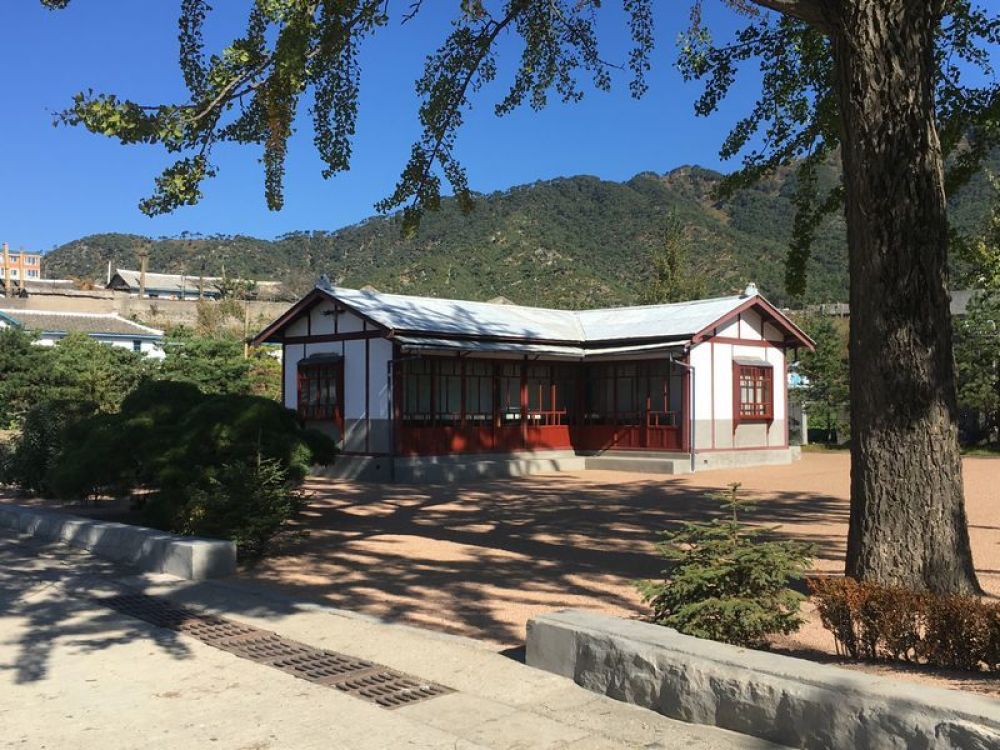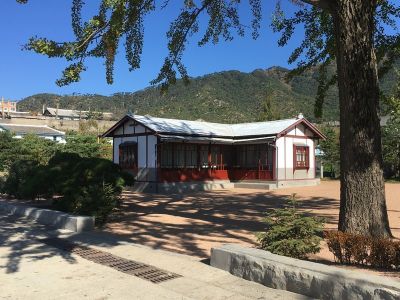

The Sonbong Revolutionary Museum offers a historical tour through the revolutionary past of North Korea. Visitors can expect to delve into a narrative that focuses on the anti-Japanese struggle and the role of the Korean Workers' Party in the region's liberation. The museum displays various artifacts, photographs, and documents highlighting significant events and figures in North Korean history. Additionally, it portrays the life and revolutionary activities of the founding leader Kim Il-sung and his son Kim Jong-il. The curated exhibits provide insight into the country's ideology and the importance of the site in shaping the nation's narrative. As with most museum tours in North Korea, the interpretation is tightly controlled and reflects the government's perspective on history.
The Revolutionary Martyrs Cemetery in Sonbong is a somber and solemn place dedicated to those who fought against the Japanese occupation. Visitors are guided through rows of statues and tombstones, each etched with the stories of fallen heroes and their contributions to the DPRK's revolutionary history. The site is often visited by local school children and military groups as a part of their education and indoctrination into the country's narrative, with an emphasis on patriotism and sacrifice. As a foreigner, this tour provides a poignant look into how the past is revered and how memory is institutionalized in North Korea. Visitors should be prepared for a deeply ideological presentation and show respect at all times, as such sites are of great significance to the locals.
The Tumen River, bordering China and Russia, offers a rare glimpse into North Korea's more tranquil side. A guided boat ride on this serene river not only provides beautiful scenic views but also an opportunity to see the contrast between the North Korean countryside and its neighbors. While the boat does not cross into international waters, it skirts the boundary, presenting a unique perspective on the geopolitics of the region. The tour focuses on the natural beauty as well as the historical significance of the river as a site of commerce and, in some cases, attempted defections. The experience is surreal and is often accompanied by local narratives about the importance of the Tumen River to the nation's security and economy.
An exclusive chance to visually experience the convergence of three nations, the Tri-Border Observation Tour presents a fascinating geopolitical excursion. The tripoint where North Korea, China, and Russia meet can be viewed from elevated vantage points in the Sonbong region. This activity usually includes a guided explanation of the historic and contemporary relations between the DPRK and its two giant neighbors. It's a rare opportunity to discuss and learn about the complexities of regional dynamics, trade, and security interests that affect this part of the world. Tour guides narrate the significance of the borderlands, often with a nationalistic fervor, and highlight the strategic importance of Rason's port and the Special Economic Zone.
Exploring a local market in Sonbong is a rare chance to interact, albeit limitedly and often under supervision, with everyday North Koreans. The market might offer a range of products from local foodstuffs to clothing and electronics, offering a glimpse into the daily lives and consumer culture of one of the world's most reclusive nations. The experience is eye-opening as it sheds light on how local economies function within the parameters set by the state. Visitors should be mindful of local regulations surrounding photography and direct engagement with sellers. It's a controlled window into the resourcefulness and reality of life for the citizens of Sonbong and a chance to observe a less orchestrated side of North Korea.
The Rason Port is a pivotal economic zone for North Korea, offering insight into the limited international trade of the DPRK. A visit to the port allows tourists to observe cargo ships and potentially the loading and unloading process of goods. The visit is typically accompanied by a guide who provides information on the significance of the port and its history. It’s an educational experience, particularly in understanding North Korea's efforts to develop trade links despite international sanctions. Additionally, the seaport can sometimes offer maritime vistas, fresh sea air, and a tangible sense of North Korea's connection to the outside world, albeit heavily regulated and restricted. Like all activities in North Korea, the visit to the port will be highly controlled, with the visitor experience carefully curated.
Wiwon Beach is one of the undisturbed natural beauties in the Sonbong area, providing an opportunity to relax by the seafront and experience relative tranquility. Walks along the sandy shoreline offer vistas of the sea, and if visiting during the appropriate season, one might even see locals enjoying the beach. It's also a place to witness another side of North Korean culture—leisure and recreation. However, visitors should not expect typical beach amenities, and the presence of government minders ensures that interactions with locals, if allowed, are within prescribed bounds. It’s a picturesque break from the more heavily indoctrinating aspects of a tour in the DPRK.
The Rason Special Economic Development Zone is an area designated for foreign investment and light industry, making it a unique example of North Korea's attempts at economic reform. A tour of this development zone provides insight into various factories and businesses that operate with international investment. It's a chance to see a different narrative about North Korea – one of potential economic growth and cooperation. Guides will explain the legal framework that governs the zone and may detail joint ventures that have taken place. However, due to the nature of tours in North Korea, visits to these zones are carefully managed, with limited interaction or deep-dive insights into their operational success or difficulties.
Cultural performances in North Korea are a spectacle of color, music, and tightly choreographed dances. Attending a cultural performance in Sonbong typically presents traditional Korean music and dance routines, potentially combined with revolutionary themes. These performances are a dazzling display of national pride and artistic prowess and often depict historical narratives or contemporary achievements of the DPRK. The experience can range from attending a larger, staged show to a more intimate local school or community performance. Audience members are expected to show appreciation for the skill and effort of the performers, and these events can be a highlight that showcases the country's rich cultural heritage within a structured and celebratory atmosphere.
Walking through Sonbong, visitors can engage in a guided tour of historical landmarks that are tied to the revolutionary heritage of the region. This walking tour may include visiting monuments, statues, and memorial parks dedicated to North Korean leaders or significant events in the country's fight against Japanese occupation. Visitors are usually provided with detailed explanations of each site's historical significance and its relevance to the people of the DPRK. These tours are important for understanding the propagated history and learning about the sites that play a crucial role in the state's narrative. The experience is both an exercise in history and an observation of how historical memory is constructed and preserved in North Korea.
